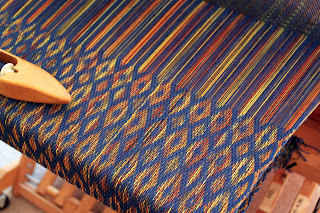This year I started out with a resolution to learn some new things and think a bit outside my comfort zone - in all things, not just weaving. I've been weaving more than blogging, but I'm hoping that is about to change too because I've had some good adventures in trying new things.
One of the biggest hurdles for me in doing something new is that I really don't like failures anymore. Truth is, I've never been comfortable with failures and it keeps me from taking chances. Good trait for staying alive, but not so good if you want to gain new skills.. Over the next few months, I'll share some of my experiences. Mostly, it's been good stuff to share and luckily I didn't take pictures of some of the more stressful moments in learning to warp with a paddle. But, I'll write a bit about it in a later post.
One of the first things I started out with this year was making some lap robes for local seniors in a project called Holiday Cheer. I wasn't selling much in the way of shawls - bad economy or maybe my shawls aren't as fabulous to other folks as they were to me:-) I thought that weaving for a good cause might be the ticket to trying something new. I read a bit about the sizes for lap robes, that they shouldn't have fringe if you were using them in a wheelchair and that they needed to be machine washable and dryable. I settled on using up some rather thick cotton yarn I had in two colors - red and brown. They wrapped at 20 epi. I futzed around with this draft and that, but nothing hit my fancy. I thought about doing them in network twills, but then remembered a recent article in Handwoven (March-April 2011) by Mary Berent. She used turned taquete for dish towels sett at 40 epi. I figured if I used 20 epi with my yarns, they would result in the warp face I needed for my heavier lap robes. I didn't find the draft in Handwoven instructive enough for me to do my own design, so I went in search of other information about drafting it. What I came up with isn't turned taquete , but I stumbled across a design that worked beautifully. I converted my design threading (in this case I used a network threading from a previous project) to a parallel threading. The tie up for 24 shafts was a 12/12 twill. For 8 shafts the tie up would be 4/4 twill. Add an alternating tabby or basket tie down with an interesting treadling sequence and you have the recipe for a warp faced design with lots of drape.

I wove six lap robes using a 16/2 red cotton weft that virtually disappears. They are about the size of beach towels and have a pleasing heft to them. One of the wonderful things about the threading was that I could weave a double weave hem. I wove a top and bottom layer and tucked the fabric back inside itself and closed it with a blind stitch.
Having had one success led me to another project on my Baby Wolf. Eight shafts with a point threading and treadling led to the draft shown below.
This project was outside my color comfort zone and was therefore appropriate for my year long study.
Painted super-wash wool that I dyed a couple of years ago along with dark blue Alpaca for the warp. The weft was 20/2 rayon in navy. The navy weft tones down the bright colors of the super-wash wool but is still not intrusive on the overall design.
Hey - this is a pretty neat structure. Does anyone have a name for it?







